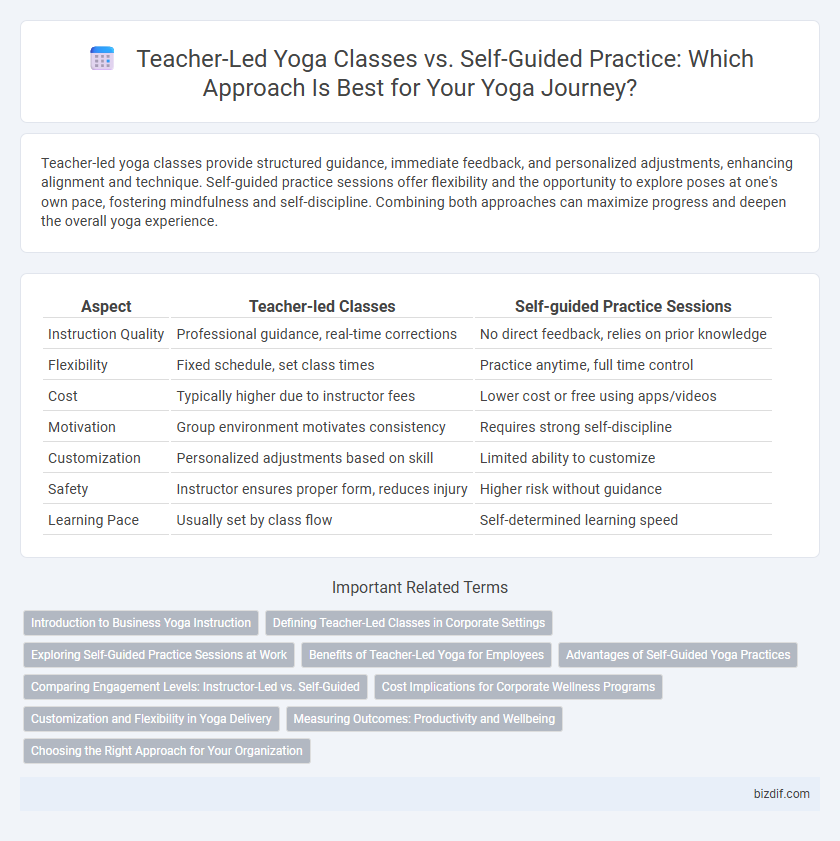Teacher-led yoga classes provide structured guidance, immediate feedback, and personalized adjustments, enhancing alignment and technique. Self-guided practice sessions offer flexibility and the opportunity to explore poses at one's own pace, fostering mindfulness and self-discipline. Combining both approaches can maximize progress and deepen the overall yoga experience.
Table of Comparison
| Aspect | Teacher-led Classes | Self-guided Practice Sessions |
|---|---|---|
| Instruction Quality | Professional guidance, real-time corrections | No direct feedback, relies on prior knowledge |
| Flexibility | Fixed schedule, set class times | Practice anytime, full time control |
| Cost | Typically higher due to instructor fees | Lower cost or free using apps/videos |
| Motivation | Group environment motivates consistency | Requires strong self-discipline |
| Customization | Personalized adjustments based on skill | Limited ability to customize |
| Safety | Instructor ensures proper form, reduces injury | Higher risk without guidance |
| Learning Pace | Usually set by class flow | Self-determined learning speed |
Introduction to Business Yoga Instruction
Teacher-led yoga classes provide structured guidance, ensuring proper alignment and personalized adjustments that enhance student safety and progress. Self-guided practice sessions offer flexibility and foster individual discipline, allowing practitioners to explore poses at their own pace. Business yoga instruction benefits from balancing these approaches, attracting diverse clients while optimizing class schedules and resource allocation.
Defining Teacher-Led Classes in Corporate Settings
Teacher-led classes in corporate settings involve guided yoga sessions facilitated by certified instructors who tailor practices to workplace wellness goals and employee needs. These sessions emphasize real-time feedback, proper alignment, and modifications to accommodate varying skill levels and physical limitations. Structured schedules and professional expertise ensure consistent progression and foster a supportive environment for stress reduction and improved productivity.
Exploring Self-Guided Practice Sessions at Work
Self-guided yoga practice sessions at work offer flexibility and personalized pacing, allowing employees to integrate mindfulness and movement during breaks. These sessions promote stress reduction, improve concentration, and enhance overall well-being without the constraints of scheduled teacher-led classes. Utilizing guided videos or apps, individuals can tailor practices to their specific needs, fostering consistent habits that support productivity and mental clarity.
Benefits of Teacher-Led Yoga for Employees
Teacher-led yoga classes provide structured guidance that helps employees maintain proper form and reduce the risk of injury, enhancing overall safety during practice. These sessions foster a sense of community and accountability, boosting motivation and consistent participation among team members. Expert instructors can tailor sequences to address specific workplace stressors, promoting mental clarity and physical well-being.
Advantages of Self-Guided Yoga Practices
Self-guided yoga practices offer flexibility in scheduling, allowing practitioners to tailor sessions to their individual needs and progress at their own pace. These sessions encourage deeper self-awareness and mindfulness by fostering personal exploration without relying on external guidance. Additionally, self-guided practices can be more cost-effective, eliminating the need for paid instruction while still promoting consistency and commitment.
Comparing Engagement Levels: Instructor-Led vs. Self-Guided
Instructor-led yoga classes often generate higher engagement levels due to real-time feedback, personalized adjustments, and motivational cues from the teacher. Self-guided practice sessions provide flexibility but may lack the accountability and immediate corrections that enhance technique and focus. Studies show participants in teacher-led environments report increased motivation and sustained attention compared to solitary self-practice.
Cost Implications for Corporate Wellness Programs
Teacher-led yoga classes in corporate wellness programs offer personalized guidance and structured routines but often come with higher costs due to instructor fees and scheduling logistics. Self-guided practice sessions reduce expenditures significantly by leveraging digital platforms and recorded content, providing flexibility while minimizing staffing expenses. Companies balancing budget constraints and employee engagement should evaluate the long-term return on investment when choosing between these two formats for workplace wellness initiatives.
Customization and Flexibility in Yoga Delivery
Teacher-led yoga classes offer structured guidance and real-time adjustments tailored to individual skill levels, enhancing alignment and technique precision. Self-guided practice sessions provide unparalleled flexibility, allowing practitioners to customize routines based on personal goals, schedule constraints, and preferred intensity. Combining both approaches maximizes yoga benefits by addressing personalized needs while accommodating lifestyle variations.
Measuring Outcomes: Productivity and Wellbeing
Teacher-led yoga classes offer structured guidance that enhances correct posture and alignment, leading to measurable improvements in physical productivity and mental wellbeing. Self-guided practice allows for personalized pacing and flexibility, which can boost intrinsic motivation and stress reduction, yet may require self-discipline to achieve consistent benefits. Metrics such as heart rate variability, cortisol levels, and productivity ratings provide objective data to compare the effectiveness of these different instructional methods on overall health and performance.
Choosing the Right Approach for Your Organization
Teacher-led yoga classes provide structured guidance, personalized corrections, and a cohesive community experience that enhances engagement and motivation for participants. Self-guided practice sessions offer flexibility, allowing individuals to tailor their practice according to their schedule and skill level, which can increase accessibility and convenience. Organizations should assess participant needs, resource availability, and desired outcomes to determine whether a guided or independent approach aligns best with their wellness goals.
Teacher-led Classes vs Self-guided Practice Sessions Infographic

 bizdif.com
bizdif.com